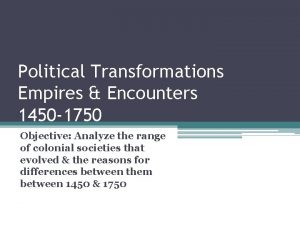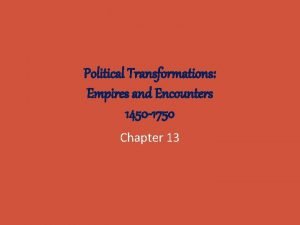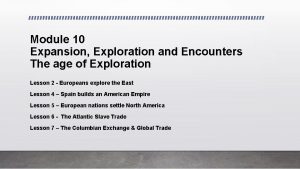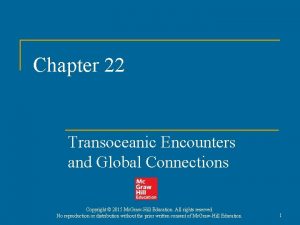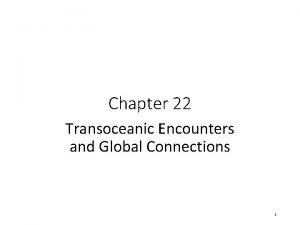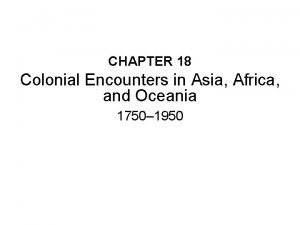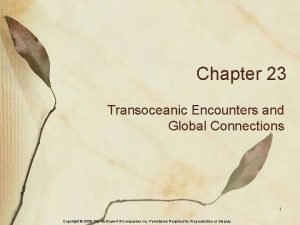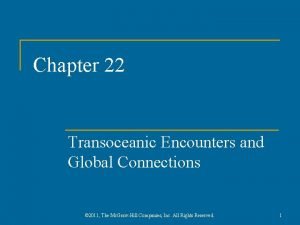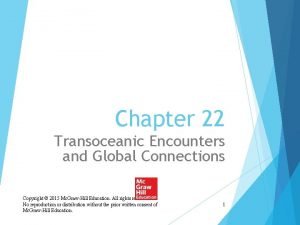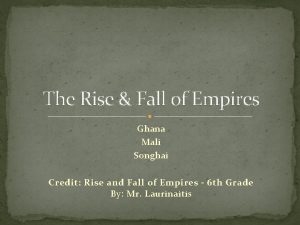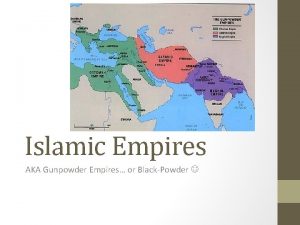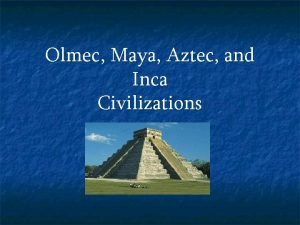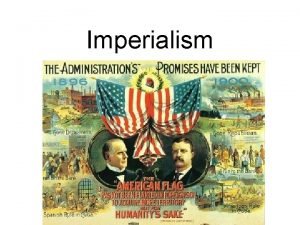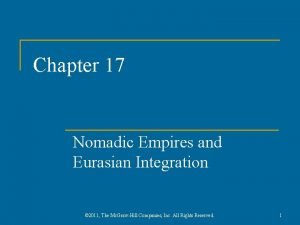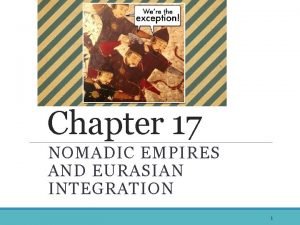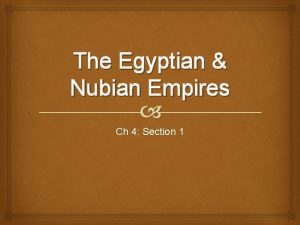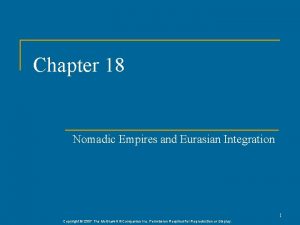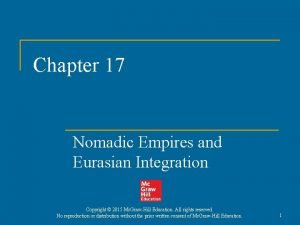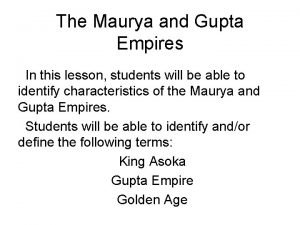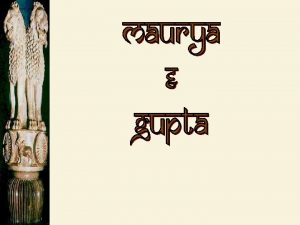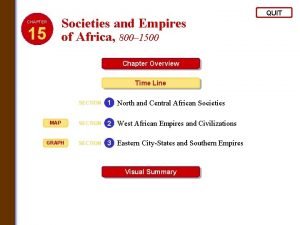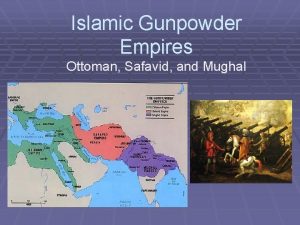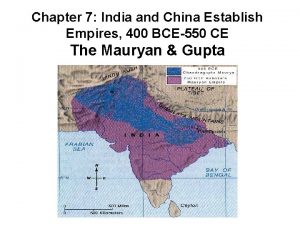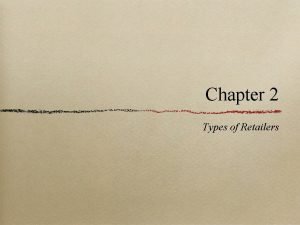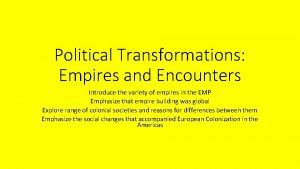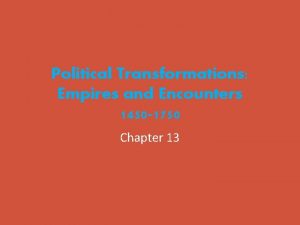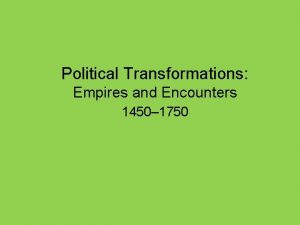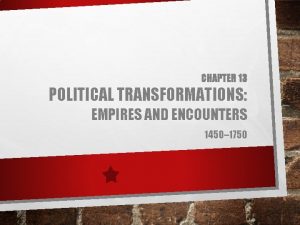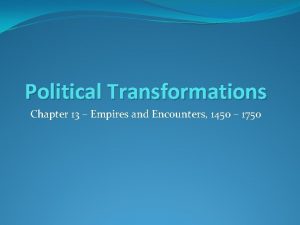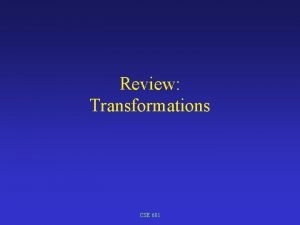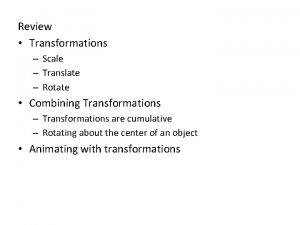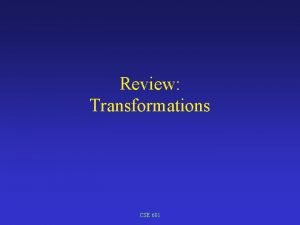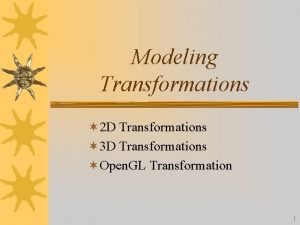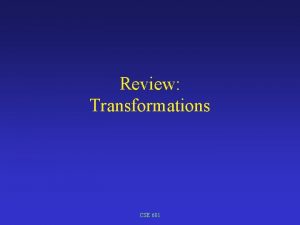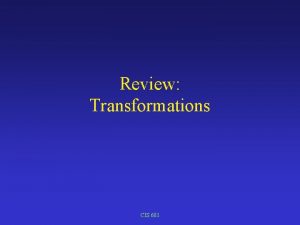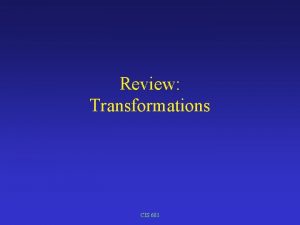Political Transformations Empires and Encounters Introduce the variety






















































- Slides: 54

Political Transformations: Empires and Encounters Introduce the variety of empires in the EMP Emphasize that empire building was global Explore range of colonial societies and reasons for differences between them Emphasize the social changes that accompanied European Colonization in the Americas

Introduction • Many empires die: during the 20 th century the Austro-Hungarian, German, Russian, Belgian, French, British, Ottoman, Portuguese, Italian all were swept away. During the EMP it was different. • The EMP marked a phase of empire building • European colonies in the Americas were particularly significant • Russia also constructed a colonial empire in Central Asia and Siberia • Qing China (Manchu) doubled its size through conquest and colonization • Mughal India brought together Hindus and Muslims; Ottomans reestablished empire in the old Islamic Caliphate of the Middle East During the last half century, empire building has become discredited

Europeans Empires in the Americas

The European Sea Empires • Land colonies were essentially extensions of expansion at sea. • As European colonies were established on islands and as enclaves it became necessary to protect them by seapower. This wasn’t cheap so more territory was taken and then more to justify the expense, etc. • By 1750 Europeans controlled most of the areas and peoples of the Americas • Spain, Portugal, France, England, Scotland, Denmark, Sweden, Netherlands, Spain were some of the maritime states interested in accumulating power in the Americas.

The European Advantage • Geographical: Atlantic European states were positioned well for involvement in the Americas • Need: Chinese and Indians had and controlled rich markets so there was no reason for Europeans to expand beyond trade with them (at this time) that is, Europe had no interest in taking them over. • Marginality: Europe was peripheral to Asian trade and commerce, knew it, and wanted to change it • Rivalry: competition between states and then nations; rulers competed to be more successful; a man thing I guess

The European Advantage • Growing merchant class in wealth and, soon, political power, wanted direct access to Asian wealth • Wealth and status: • Colonies were an opportunity for impoverished nobles and commoners who had little opportunity at home • Religion: for some, empire building was a crusade for religious purposes; could also be havens for groups fleeing oppression or persecution for manner, belief, or style of worship ( in some colonies)

The European Advantage • European states and trading companies organized and managed resources well • Good seafaring technology • Iron weapons, cannon on ships, horses, gave them an edge over American peoples • Rivalries and enmities among native peoples also gave European interlopers allies

WHEN WORLDS COLLIDE

THE GREAT DYING • Population collapse in the Americas • Pre-Columbian population in the Americas 60 -80 million? ? • No immunity to Eastern Hemisphere diseases from Eurasia or Africa • Up to 90% of Native Americans may have died in the 1 st century after contact with Europeans/Africans • Islands completely depopulated and repopulated with slave labor • Mexico: population fell from 20 million to 1 million by 1650 or 95% • Across North America and Northwestern South America similar death rates were seen.


The Columbian Exchange • Severe labor shortage in Americas as a result of indigenous deaths • Migrant Europeans and African slaves created entirely new societies in the Americas • Brought European and African crops to the Americas • Brought European and African animals to the Americas It should be noted that many more African slaves than Europeans came to the Americas prior to the 19 th century.


The Columbian Exchange • From America with love: • American food crops spread quickly and widely across the planet • Maize, Tomatoes, Potatoes, Squashes, Beans, Peppers, tapioca • Potatoes allowed European population in particular to explode • Corn and sweet potatoes were important food additions in China and much of Asia • American non-food agricultural products like chocolate and tobacco also enjoyed tremendous growth in the Eastern Hemisphere


The Columbian Exchange • The World Economy was globalized and reshaped due to trade with and among the American colonies of European powers • Silver mines in Mexico and Peru created inflation in Europe by oversupplying money and the Chinese were drowning in silver from all the Spanish beating down their door to buy stuff in the Philippines • The silver also allowed Europeans (not just the Spanish) to purchase large numbers of slaves in West, South and East Africa • This migration of plants, animals, and disease, along with the establishing of communication and trade networks between the Americas and the world is the Columbian Exchange

Comparing Colonial Societies in the Americas

Creating New Societies • Because the native cultures and civilizations were for the most part destroyed by contact, Europeans had to erect new societies in the Americas if they wanted them to pay • All colonies were shaped by the mercantilist economic theory which says that countries should only export goods and accumulate gold and silver • Colonies provided a closed market for the mother country’s goods in return for gold and silver, a mercantilist’s dream • But, not all colonies prospered similarly nor did they resemble each other in many respects. Specific conditions in each colony caused them to vary as much as nations in Europe

Creating New Societies • If the native culture still existed colonies might be more hybrid, or mixture of the two cultures. • On the other hand, if the native culture was extinct then some blend of European and African culture was likely to emerge especially in the Caribbean Islands and in Latin America. • Women in these colonial societies had varied experiences. Elite American women usually married into Spanish conquistador’s families, while lower class women did not. If there were no native women left, Spanish and Portuguese took slave women. In Mexico and Peru (both of which meant much larger areas than today) a great mixing of people started at the conquest and continues to this day. In other areas little mixing took place as in the English North American colonies, and in others like Brazil, mixing between Europeans and Africans predominated. No doubt, many women were subject to sexual violence whether American, European, or African.

Conquering and recreating (Spain) • Between 1519 and 1540 Spanish conquistadores destroyed two great land empires in North and South America • These were the most populous, wealthy, urbanized, and productive regions in the Americas • Within a century, most of the ruin had at least been cleaned up and major cities, mining, trade, universities, religious and bureaucratic infrastructures had been set up. Keep in mind that this is with a population only 5% of what it had been, of which the Spanish constituted 5% at most.

Creating the New Colonies (Spain) • Economically the colonies were based on commercial agriculture and mining • Commercial agriculture was for export and could be any cash crop that was in demand outside the colony. Slave labor would most likely be used; however, if sufficient native Americans survived they would be turned into serfs (peons) and utilized as if they were slaves. • Mining was very lucrative for mine owners, merchants, and the king. For the miners, not so much


Spanish Colonial Society: The Castas • Spanish colonies had a distinctive social order based on many things, but mainly on wealth and color. • Each mixture of people was given a distinct name and place in the hierarchy of the colonial structure. • While this replicated some parts of the Spanish social structure, it ended up being much more complicated. • Race and identity in Spanish colonies were based on limpia de sangre-and this could be purchased for a sum of money if you had it. This indicates a degree of fluidity in Spanish colonies as far as casta is concerned. To a degree this reflected the reality of a society with far fewer Europeans and more mixed race along with its needs for constant replenishment of “pure” blood.

General Castas in Spanish America • European Spaniards-rule and run things • Crillollos- American born Europeans: left out and not happy about it • Mestizos- European/American Indian: becoming Number One • Mulatto- European/African : left behind • These go on for at least another 150 combinations; the above combinations reflect the Father being European for Mestizos and Mulattos. If the mother was European that was a whole different thing. • There was much more racial mixing in Latin America than in non. Spanish colonies in America for various reasons.

Castas In Spanish America

Society in Latin America • Over time Mestizos emerged as the largest segment of most Latin American societies except in Brazil • Despite this, Europeans and European-Americans dominated most aspects of life economically and politically. Mestizos were almost always in the lower socio-economic classes. Some exceptions occurred but until the 19 th century Mestizos were denied participation in most areas of power. • The Indians, at least those who were left, were treated poorly and exploited by all other levels in society.

Sugar Colonies

The Caribbean Islands and Brazil These areas developed a different economic and social structure than the Spanish colonies. The native peoples had died out in the Caribbean, and fled from the Europeans in Brazil into the Amazonian Interior. This meant that slaves had to be brought in to do the work. Lack of mineral wealth (except in Brazil after 1700) led to the development of sugar plantations throughout this region. Almost all economic development was focused on sugar production for export

Sugar Shacks • The Europeans were introduced to sugar production by Arabs in the Mediterranean. The Europeans then transferred this knowledge to the islands and other areas in the Americas • At first Portugal dominated the trade from Brazil, but soon the French, Dutch, and British established sugar colonies in the Caribbean. The most famous and productive of these were Saint Dominique (Haiti-France) and Barbados (Britain).

Sugar Production: the first modern industry • The production of sugar transformed the colonies in which it took place • Great wealth for the owners was generated, and Europeans tastes were changed • Production of sugar was labor intensive, worked best on a large scale, and was brutal to those who had to produce it (may have helped to create industrial revolution) • Had to be produced with a large slave population. • African slaves were utilized for this purpose: of all Africans enslaved over 80% were sent to Brazil or the Caribbean area.

Sugar Societies • Brazilian and Caribbean societies were mixed race as much of the population was African and the usual mixing of Europeans with their slaves took place. • Mixed race persons provided supervisors and merchant populations in the sugar colonies as well as most of the urban population • Europeans were probably less than 10% of the total population with the possible exception of Brazil. • Because of the extremely high profit generated by sugar production, Europeans were always looking for new areas in which to create plantations.

Slavery and Plantation Economies Spread • Although sugar would not grow in most of the North American mainland English colonies, slave plantation economies were developed there. Many of the owners moved to the southern English colonies from Haiti and Barbados. • Instead of sugar, these large plantations grew other cash crops such as tobacco, rice, indigo, and hemp. All of these products could be very profitable and so the system maintained itself. Towards the end of the EMP, plantation owners in the southern colonies began to grow cotton but this didn’t become a large scale industry until after 1790

AN INDIGO PLANTATION History at duke. edu

English Plantation/Slave Society • Despite many similarities to the other slave societies in the Americas, there were significant differences to English colonial slave society • First, many English settlers came as families so that the percentage of European women was much higher in the English North American colonies than in any other colonies in the Americas. • Second, native peoples were driven out or exterminated, so mestizo offspring were seldom produced • Third, there was less tolerance for racial mixing and a sharply defined racial system based on black-white skin developed unlike Latin American society with its innumerable castas • Fourth, although slavery is slavery, conditions in the English mainland colonies were more tolerable so slave working conditions and life were less harsh than in the sugar areas.

North American Settler Colonies

British Colonies in North America • Britain was a late comer to colonial development not beginning until around 1600 or later. • Colonies were in what was considered less favorable areas, but Britain pursued the process anyway. • British society was changing/modernizing more quickly than any other European nation. Britons saw more options in colonization, many colonies began as “utopian” refuges, and many more British than Spaniards migrated to the Americas. • By 1750 5 times as many British as Spanish lived in the Americas

British North American Colonies • By 1776 British North American colonies were heavily European up to 90% of all people there. The rest were mostly Africans • Native peoples had either been exterminated or driven away by policy or disease. • The small scale farming practiced in all but a few of the mainland colonies did not want or need slaves • Britons were Protestants and many in the Americas were looking to be left alone. Unlike Spanish Catholics, these colonists were not concerned with native souls and did little missionary work at this time

British North American Colonies • Due to several factors (English Civil War, Glorious Revolution, French Wars) Britain paid less attention to its colonies than other European nations. • British government was less bureaucratic, less authoritarian, and did not develop a colonial department until after the American Revolution • British colonies modeled their own governments on England, creating mini-parliaments with considerable powers, and placing governors, whether elected or royally appointed, securely under the power of the colonial assemblies. This was unlike Spain, in which all control was kept in the hands of royal authorities in the colonies and in Spain.

British North American Colonies • This meant, that unlike the Spanish and French colonies in America, the English colonials ran their own affairs for the most part, participated fully in government, became used to religious toleration, and built a society that while different in some respects, was much closer to the British society from which it arose than any Spanish colony in the Americas. • This may have been a decisive factor in the relatively successful development of the USA after independence when compared to Latin American nations.

The Making of the Russian Empire

Early Expansion of Russia • After throwing of the Mongol yoke, a small Russian state emerged centered on Moscow c. 1500 • Over next 300 years this state conquered other small states and grew into a massive empire • Early expansion: into grasslands (steppes) to the S and E was to deter nomadic raiders • Expansion into Eastern Europe and Siberia was opportunistic and not to deter any threat

How did Russia get its Empire? • Conquest was made possible by use of modern arms and organization beginning with Peter I • Under Russian rule: conquered people were devastated by disease just as in the Americas; forced to convert to Russian Orthodox Christianity; cede land to large numbers of Russian migrants (some of whom were involuntary); forced to disband pastoral lifestyles for sedentary farming/mining; forcibly made to speak and learn Russian language and Russian social customs. This is called Russification. • As a side note: much the same process would be seen in the USA in regard to native peoples only there it was called Americanization.

Russia and Its Empire in the EMP • Ethnic Russians became a smaller portion of the population as they gained control of Central Asian, East Asian, and Eastern European areas. • Development of fur industries, agricultural lands, and minerals helped make Russia a great power by 1750 • Due to its large area it was both an Asian and European power • Became a largely militarized society. The power of the Tsar was absolute and became known as “The Autocracy”. Little movement away from this political norm occurred until the late 19 th century

Russia and Its Empire • Some differences between Russia and European colonization in the Americas • Russia had long had contact with and interacted with the territories it conquered • The Russian state developed at the same time as it was expanding its empire unlike most European states who were colonizing • The Russian Empire or its successor remained intact until 1991. And its successor the Russian Republic is trying to recreate it at present.

Asian Empires to 1750 ASIAN EMPIRES WERE REGIONAL AND NOT GLOBAL LIKE EUROPEAN EMPIRES. DID NOT TRANSFORM HOMELANDS WITH EMPIRE NOR WERE THERE MAJOR EPIDEMICS.

Making China an Empire • Qing Dynasty (1644 -1912) expanded China enormously from its Ming territory especially north and west. • The Qing were actually a nomdic Manchu ethnic group from the North and the nomads in all regions were already familiar to most Chinese • By 1760 most of territory that would be present day China had been conquered • China evolved into a Central Asian Empire as well as an East Asian one • Qing remained aloof from Chinese culture but were influenced by it anyway

Making China an Empire • The Zunghars (Mongols just west of China) helped to motivate the expansion as the Chinese had not forgotten Mongol rule • Conquered territory was ruled separately through the Court of Colonial Affairs and not as part of China • Used local elites to govern; officials imitated Chinese ways; little assimilation of conquered peoples; little Han (Chinese) settlement in conquered regions • Central Asia under the rule of China and Russia becomes poorer and exploited unlike under the nomadic Mongol or Turkic peoples

Mughal India

Muslims and Hindus in the Mughal Empire • Mughals united much of the Indian sub continent between 1526 and 1707 • Most important factor in divisions within the Mughal Empire were religious • Akbar: Emperor (1556 -1605), tried to accommodate the Hindu majority- brought many Hindus into political/military elite; created religious toleration; syncretic state religion created incorporating aspects of Islam and Hinduism stressing loyalty to the emperor; encouraged (with his successors save one) a hybrid Indian-Persian. Turkic culture

Mughal Empire • Toleration of Hinduism provoked some ruling class Mughals to react adversely • Aurangzeb (reigned 1657 -1707) did away with toleration of other religions than Islam. Imposed Islamic supremacy; reimposed jizya, banned widow burning (sati), music, dancing, and tobacco. • Some Hindu temples were destroyed as well. • These actions provoked Hindu reaction and may have well allowed an inroad for the British later in the 18 th century.

Ottoman Empire: Muslims and Christians in the Middle East to 1750

The Ottoman Empire • World’s most important Islamic state in the early modern period. Development of empire transformed Turkish society; Persianization of Ottoman court led to loss of status for elite women and loss as well as loss of freedom (see harem) • For 100 years war between Ottoman (Sunni) and Safavid (Shia) empire to the east. War was neither won nor lost

Ottoman Empire • Significant meeting place of cultures • Anatolia (Asia Minor): most conquered Byzantine Christians became Muslim. In Balkan area, most conquered Christians remained Christian • Ottoman taxes were less oppressive and less expensive than Byzantine • Christian churches received some autonomy which was better than being persecuted under the Orthodox Byzantine church

Ottoman Empire • Many Christian elites in Balkans were accepted into Ottoman upper class without converting to Islam • Ottoman Empire served as a refuge for persecuted Jews from western Europe primarily Spain and Portugal. • Weird Fact Alert!!!!-Ottomans imposed a special tax on Christian communities in the Balkans: they had to contribute a set number of boys to the Ottoman state where they were converted to Islam, trained in loyalty to the Empire, and made into elite troops. Provided a means of upward mobility in society

The Ottoman Empire • From 1500 until 1700, the Ottoman Empire was a general threat to Western Europe and a specific threat to Austria and Russia • Much of the warfare of the 16 th century and 17 th century in Europe was focused as much on Ottoman Empire as on religion. • Some European elite philosopher admired and praised the Ottoman Empire specially for its religious toleration • Many admired the great Sultan Sulieman as well
 Political transformations empires and encounters
Political transformations empires and encounters Chapter 5 political transformations empires and encounters
Chapter 5 political transformations empires and encounters Maritime empires vs land empires
Maritime empires vs land empires Expansion exploration and encounters
Expansion exploration and encounters Encounters and foundations to 1800
Encounters and foundations to 1800 Pencounters
Pencounters Encounters and foundations to 1800
Encounters and foundations to 1800 Colonial encounters in asia africa and oceania
Colonial encounters in asia africa and oceania Traditions and encounters chapter 22
Traditions and encounters chapter 22 Chapter 22 traditions and encounters
Chapter 22 traditions and encounters Chapter 18 colonial encounters in asia and africa
Chapter 18 colonial encounters in asia and africa Chapter 23 transoceanic encounters and global connections
Chapter 23 transoceanic encounters and global connections Chapter 22 transoceanic encounters and global connections
Chapter 22 transoceanic encounters and global connections Bentley and ziegler
Bentley and ziegler Transoceanic encounters and global connections
Transoceanic encounters and global connections Christ encounters
Christ encounters Types of critical lenses
Types of critical lenses Close encounters challenges
Close encounters challenges Chapter 1 section 5 transatlantic encounters
Chapter 1 section 5 transatlantic encounters Transatlantic encounters in history of education download
Transatlantic encounters in history of education download The rise and fall of songhai
The rise and fall of songhai How did the ottoman safavid and mughal empires arise
How did the ottoman safavid and mughal empires arise Olmec maya aztec inca map
Olmec maya aztec inca map The policy of establishing colonies and building empires
The policy of establishing colonies and building empires Chapter 17 nomadic empires and eurasian integration
Chapter 17 nomadic empires and eurasian integration Chapter 17 nomadic empires and eurasian integration
Chapter 17 nomadic empires and eurasian integration Chapter 4 section 1 the egyptian and nubian empires
Chapter 4 section 1 the egyptian and nubian empires Ottoman, safavid, and mughal empires venn diagram
Ottoman, safavid, and mughal empires venn diagram Chapter 18 nomadic empires and eurasian integration
Chapter 18 nomadic empires and eurasian integration Chapter 17 nomadic empires and eurasian integration
Chapter 17 nomadic empires and eurasian integration Aztec farming
Aztec farming The maurya and gupta empires
The maurya and gupta empires The maurya and gupta empires
The maurya and gupta empires Venn diagram of mauryan and gupta empires
Venn diagram of mauryan and gupta empires Hyperbole in to his coy mistress
Hyperbole in to his coy mistress The maurya and gupta empires
The maurya and gupta empires Chapter 15 societies and empires of africa
Chapter 15 societies and empires of africa Impaler state of decay 2
Impaler state of decay 2 The egyptian and nubian empires
The egyptian and nubian empires Chapter 7 india and china establish empires
Chapter 7 india and china establish empires Restrictive nonrestrictive clauses
Restrictive nonrestrictive clauses Her name
Her name How to write advantages and disadvantages
How to write advantages and disadvantages Good morning distinguished guests
Good morning distinguished guests Advantages and disadvantages essay linking words
Advantages and disadvantages essay linking words Process volume and variety
Process volume and variety Examples of opposition in interior design
Examples of opposition in interior design Extreme value retailers
Extreme value retailers Product variety and quality under monopoly
Product variety and quality under monopoly Refers to the equalization of elements in a work of art
Refers to the equalization of elements in a work of art Volume velocity variety and veracity
Volume velocity variety and veracity Product variety and quality under monopoly
Product variety and quality under monopoly Number and variety of pets
Number and variety of pets Variety and variability
Variety and variability Hình ảnh bộ gõ cơ thể búng tay
Hình ảnh bộ gõ cơ thể búng tay
